Last Updated on March 31, 2025 by Owen McGab Enaohwo

Imagine moving around in a cluttered workspace with stacks of papers everywhere, tools scattered about, and no clear path from point A to point B.
Frustrating, right?
Now, picture the same workspace as clean, organized, and efficient, where every item has its place, and everything runs like a well-oiled machine. That’s the beauty of streamlining processes in a business.
According to a survey by The Alternative Board, 72 percent of small business owners already feel overwhelmed. This can be attributed to their chaotic responsibilities, screaming for some order. Therefore, there is a need to cut out chaos and create a smooth, efficient workflow process that saves time and reduces stress.
When processes are transparent and efficient, everyone knows their role, which means less time wasted and more productivity. But how do you get there? And what tools can help you achieve this level of organization and efficiency? This is where SweetProcess comes in, with its unique features that will support your team as the tool needed to streamline your processes.
Ready to transform your business chaos into order? Start your journey with SweetProcess. Discover how the platform can simplify your workflow, enhance productivity, and give you peace of mind. Use the 14-day free trial now to explore SweetProcess and enjoy a streamlined workflow.
What You’ll Learn In This Post
What Does It Mean to Streamline a Process?
How to Streamline Business Processes: Tips & Best Practices
How to Streamline Your Business Processes Using SweetProcess
7 Tools for Streamlining Your Business Processes
How to Choose the Business Processes to Streamline
9 Benefits of Streamlining Business Processes
7 Methodologies for Streamlining Business Processes
Streamline Your Company’s Processes Effectively Using SweetProcess
What Does It Mean to Streamline a Process?
Streamlining a process means simplifying or eliminating unnecessary steps to make the process more efficient. It involves using technology and better practices to speed up tasks, reduce errors, and save money.
By implementing streamlined processes, a business shifts its focus from routine tasks to strategic growth. Business process automation tools play a significant role in this transformation. This means fewer mistakes and more time for employees to engage in activities that drive the business forward.
How to Streamline Business Processes: Tips & Best Practices

Streamlining business processes is vital for enhancing operational efficiency, cutting costs, and optimizing resource use. This, in turn, ensures smooth and effective business operations. Here are some essential tips and best practices to help you streamline your business processes.
Identify the End Goal
Knowing what you want to achieve before diving into business process improvement is crucial. Whether reducing costs, improving customer satisfaction, or speeding up delivery times, having a clear end goal will guide your efforts and keep you focused on what matters most. With clear goals, each time you are faced with choices, you evaluate options based on their overall effect on achieving your goal.
Breakdown the Process Into Manageable Tasks
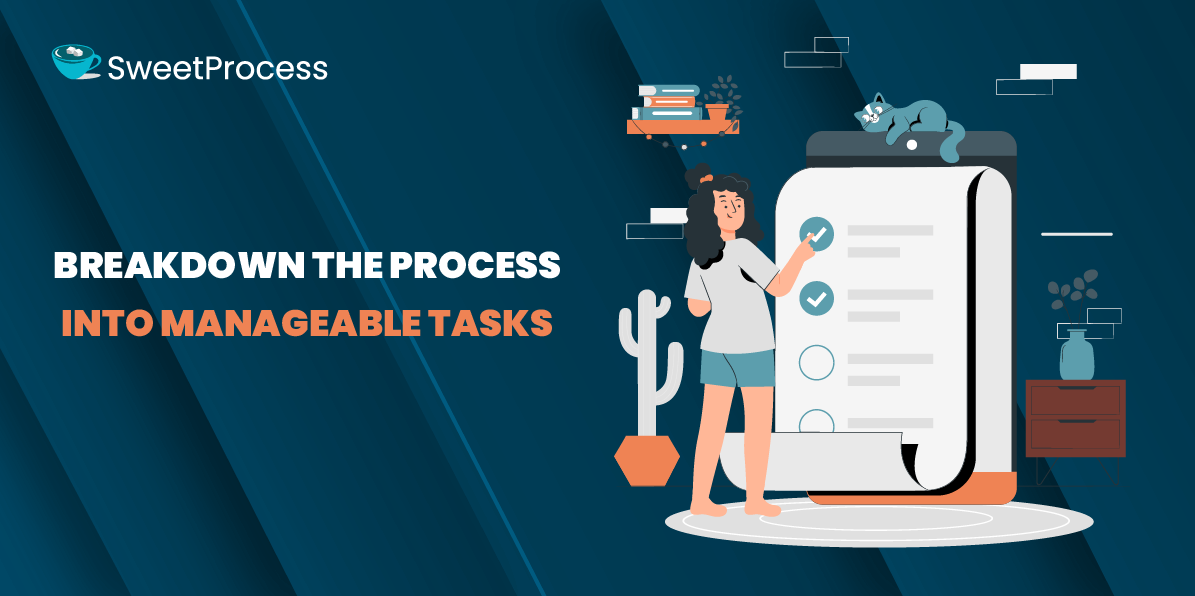
It becomes easier to manage when you break down complicated processes into smaller tasks. Refrain from handling everything simultaneously, but focus on a tiny step at a time. This feels more manageable. Since the functions are already broken down, you can easily spot where improvements are required. Using this approach keeps your team motivated and transparent about their roles.
Analyze the Process Steps and Identify Bottlenecks

Look closely at every part of the process to identify where things might go wrong. Bottlenecks are those areas where the process slows down or stops, causing delays and increased costs.
When you discover the problems, address them with targeted solutions to make the process smoother. It’s not enough to fix these issues just once; you must regularly check and refine each step to keep the process running efficiently and adapt to any change.
Gather Input From Those Who Perform the Process and Those Who Benefit From It
The best insights often come from those on the front lines. Engage with the employees who perform the tasks and the customers or stakeholders who benefit from them. Their firsthand experience can reveal pain points and practical solutions you might overlook.
Identify Redundant Activities
Redundancy is a common process efficiency killer. Identify tasks that are being done more than once or steps that don’t add value. Eliminating these redundant activities can save time and resources for more important work.
Identify Activities That Can Be Automated Using Technology

Many tasks can form an automated workflow, reducing the burden on your team and leading to increased efficiency. Look for repetitive, time-consuming tasks that technology can handle and use automation to improve productivity.
Redesign/Automate Tasks
With bottlenecks and redundant activities identified, it’s time to redesign your processes. Use business process automation tools to handle routine tasks, freeing your team to focus on more strategic work. This can lead to significant time and cost savings.
Request Resources to Deliver on the Process
Streamlining processes often requires investment in new technology, training, or additional personnel. Make a compelling case for the resources you need to implement your improved processes effectively.
Communicate the Process Plan and Gain the Stakeholders’ Approval

Communicate your process improvement plan clearly to all stakeholders and gain their buy-in. Their support is crucial for successful implementation and overcoming resistance to change.
- Lay out what the plan involves.
- Narrate the details of changes being proposed and why they’re necessary.
- Ask them for feedback and approval.
Offer Training

New processes often require new skills. Ensure that your team is adequately trained to handle the redesigned processes. Providing comprehensive training will help smooth the transition and boost confidence in the new methods.
Define Key Performance Indicators (KPIs)
KPIs are essential for measuring the success of your streamlined processes. Define clear, measurable indicators that align with your end goals. KPIs give you a clear way to judge if the changes to the process are successful. With KPIs, you make decisions based on data, not just guesswork.
Track and Report Successes and Failures

Monitor your processes regularly and report on successes and areas for improvement. This continuous feedback loop allows you to make necessary adjustments and celebrate wins, keeping the team motivated and on track.
Commit to Continuous Improvement
Streamlining processes is not a one-time effort. By embracing lean process improvement, businesses can establish an ongoing cycle of review and refinement. This methodology encourages teams to stay open to new ideas, identify inefficiencies, and adapt to evolving challenges, ensuring sustained growth and operational excellence.
Conduct a Pilot Test
Before fully implementing changes, it’s best to conduct a small-scale pilot test. Testing the changes on a small scale first allows you to spot problems early, identify potential issues, and gather real-world data. Use the feedback and data from the pilot test to refine and improve the process before a full rollout to reduce risks and increase the chances of success.
By following these tips and best practices, you can create a streamlined, efficient, and agile business that’s well-equipped to handle whatever comes its way. Ready to take the next step? Take SweetProcess for a spin and see how it can help you streamline your business processes seamlessly using the 14-day free trial.
How to Streamline Your Business Processes Using SweetProcess
Streamlining processes is essential for maintaining improved efficiency and productivity. SweetProcess effectively achieves this. The platform allows you to create, document, and manage your business processes in a well-structured and organized manner. Using SweetProcess ensures that all tasks are completed accurately and consistently.
Here’s how you can use SweetProcess to streamline your processes:
How to Create a Process on SweetProcess
Step 1: Sign up for SweetProcess
To start on the SweetProcess platform, you can sign up using the 14-day free trial.
This will give you access to the dashboard with all the features needed to streamline your business processes.
Step 2: Create a New Process
After signing up, you will be taken to the dashboard interface. Navigate to the “Processes” tab and create a new Process. Alternatively, you can select from the templates available or upload an existing process you already have.

Step 3: Name and Title the Process
Give your process a clear, descriptive title that accurately reflects the task or workflow. Add a brief description to provide context and outline the purpose of the process. This helps identify and file the process accordingly.
You can also add team members and assign tasks associated with the steps in that process. Select the relevant team member from the “Add to teams” drop-down button to do this.
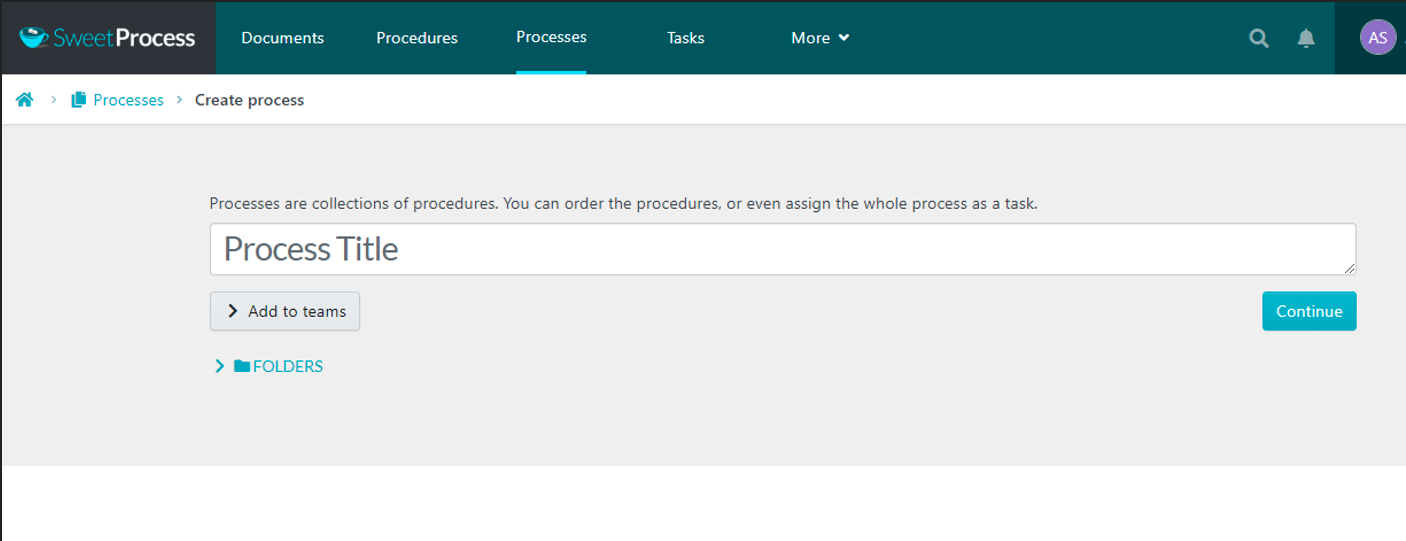
Step 4: Add the Steps
Detail each step of the process. Use clear, concise language to ensure each step is easy to follow. SweetProcess allows you to add sub-steps, making it easier to break down complex tasks into manageable actions.
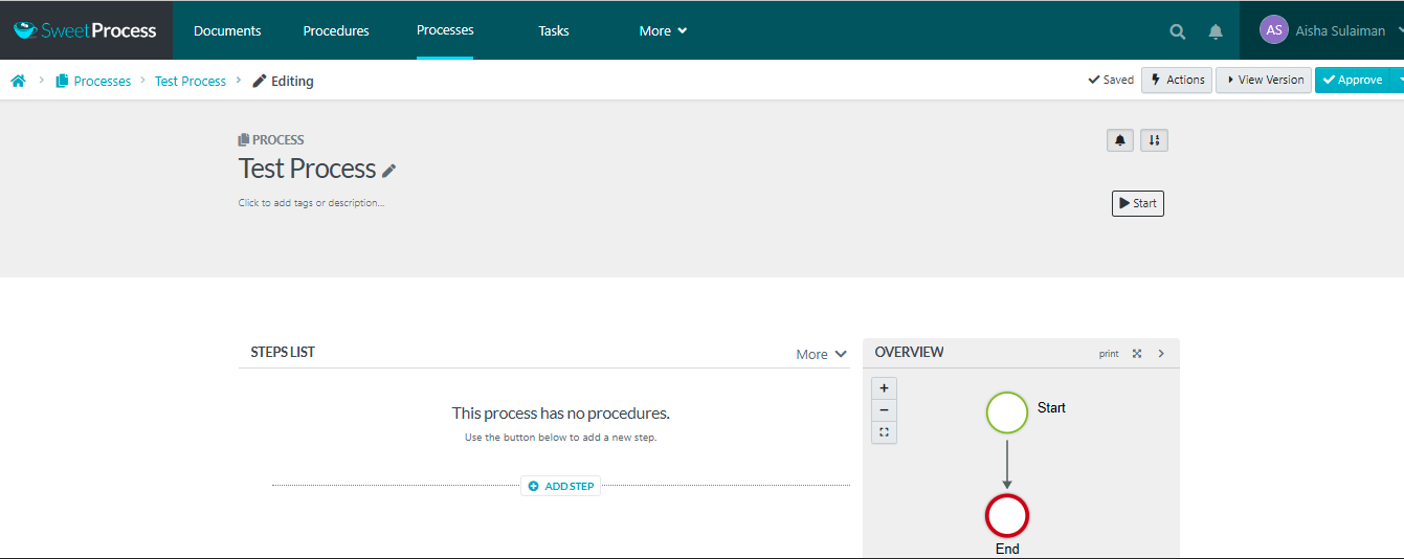
You can add relevant media, such as images or videos, to your processes. Once done, review the process and publish it so all team members receive instant notification.
Step 5: Monitor and Update the Process
Keep an eye on the process in action and gather feedback from your team. Use SweetProcess to make real-time updates and improvements, ensuring your processes stay relevant and practical.
SweetProcess makes process documentation seamless. There is no steep learning curve; users can sign up and dive straight in.
Do you want to try out your process creation or documentation on SweetProcess? Take advantage of the 14-day FREE trial to get started!
How to Automatically Create Procedures on SweetProcess
Creating procedures automatically for your company is possible thanks to the power of AI on SweetProcess. Here’s how you can leverage SweetProcess to automate the creation of your procedures:
Step 1: Sign up and Access the Dashboard
If you haven’t already, sign up for SweetProcess and log in to access the dashboard. Utilize the 14-day free trial to explore all the features.

Step 2: Navigate to the “Procedures” Tab
Go to the “Procedures” tab from the dashboard and click the “Create Procedure” button on the top right-hand corner. This will open a new template where you can begin outlining your procedure.

Step 3: Add Procedure Title
You must input the procedure title you want to create at this stage. Ensure that the title is descriptive and detailed to get the best results from the AI.

Step 4: Write the Procedure
Once you have the title, add the relevant team. To proceed, you can write the procedure manually or use AI. To use the AI to create the procedure, click “Write With SweetAI.”

At this stage, the AI will operate in the background to produce the initial draft of the procedure, typically taking less than 60 seconds.
Upon completion, it will automatically create the procedure’s steps, descriptions, and flowchart.
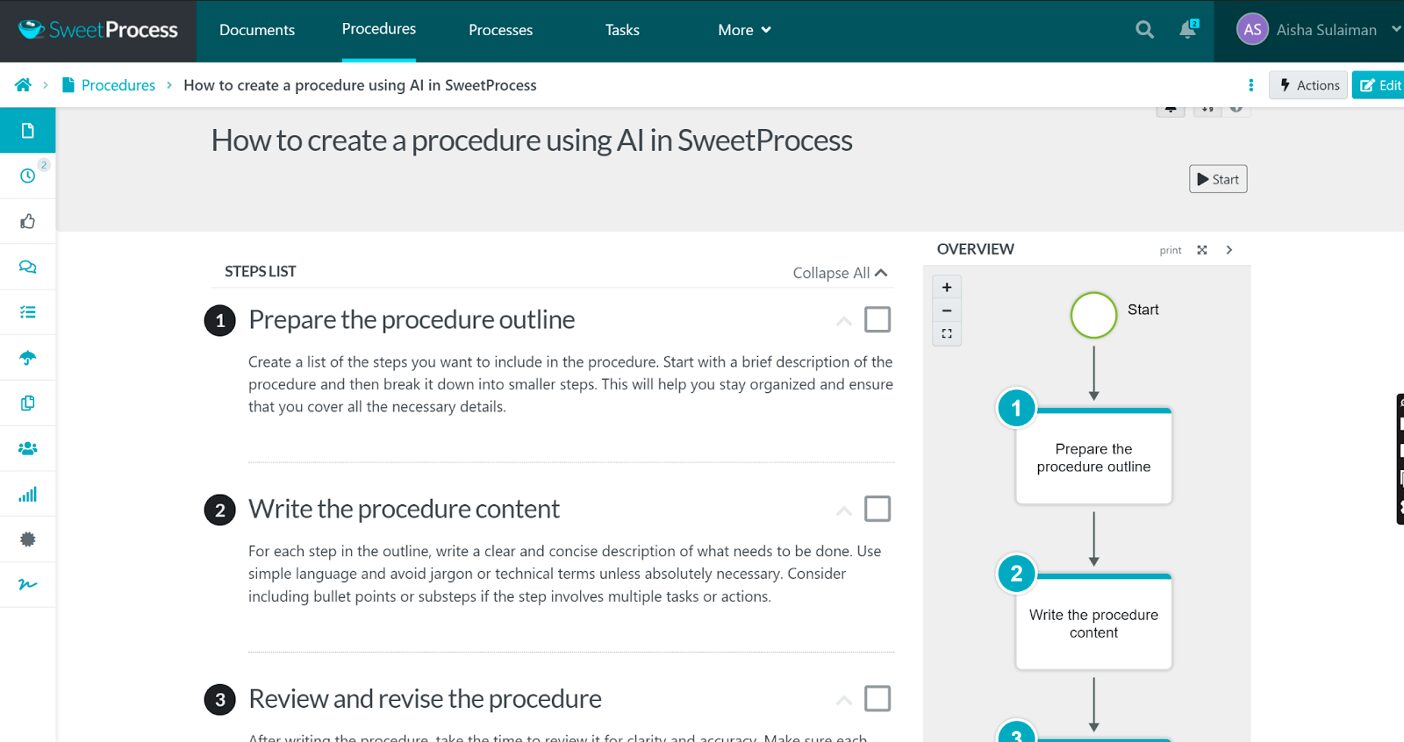
You can then review the procedure and edit accordingly.
Step 5: Finalize and Publish the Procedure
Once you are satisfied with the procedure, finalize and publish it within SweetProcess. This makes the procedure available to your team, ensuring everyone can access the latest, most accurate information.
How to Add a Procedure to a Process on SweetProcess
SweetProcess has many features, including the ability to help you add a procedure to your processes. Here’s how you can do that on SweetProcess:
Step 1: Select Process
While on the dashboard, navigate to the process you want to add the new procedure.

Step 2: Click on “Add Procedure”
Look for the “Add Procedure” button at the bottom within the selected process. A new window will prompt you to enter the title and a brief procedure description. Ensure the title is descriptive enough to convey the purpose of the procedure.
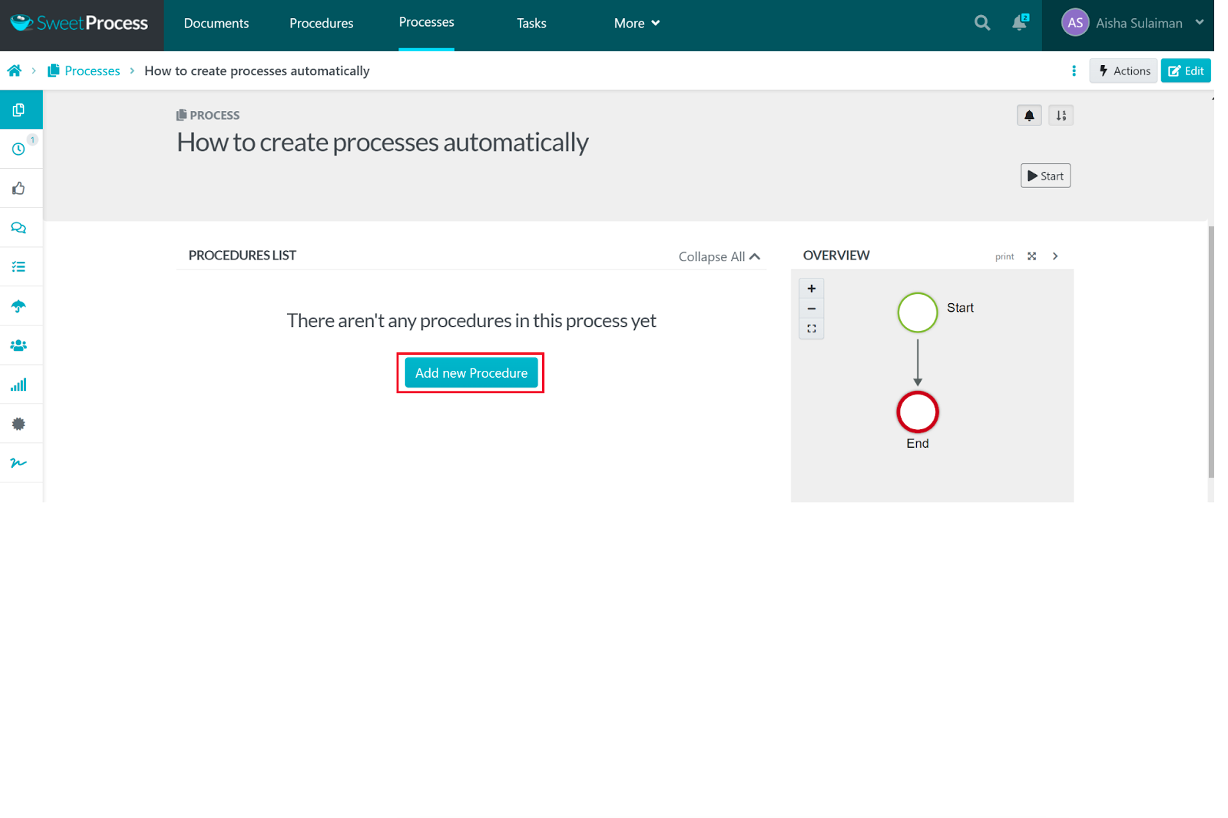
Step 3: Define the Steps of the Procedure
Start adding the individual steps that make up the procedure. Use clear and concise language to ensure each step is easy to understand. SweetProcess allows you to break down complex tasks into smaller, manageable actions.
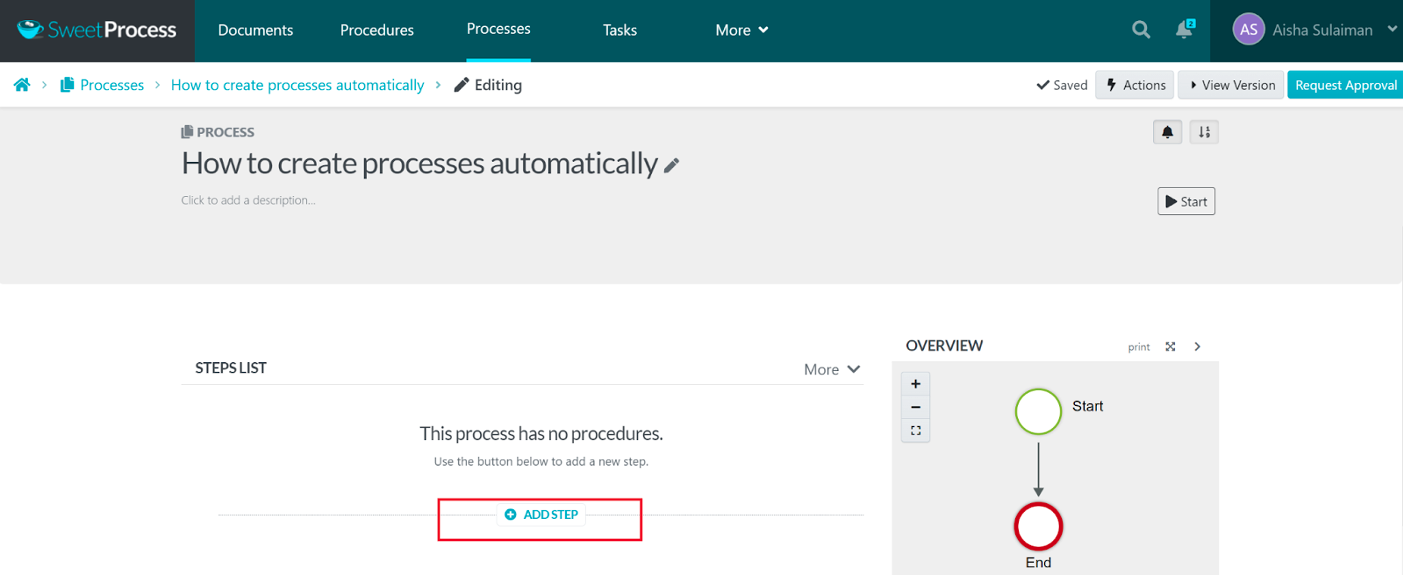
Step 4: Publish the Procedure
Once satisfied with the procedure, click the “Publish” button. This will make the procedure live within the selected process, allowing your team to access and follow it.
Note that only the admin can publish, and as a team member, you’ll need to request approval to publish the edited procedure.
How to Manage Your Processes and Procedures Seamlessly on SweetProcess
Efficient process management of processes and procedures is crucial for maintaining productivity and ensuring your business operations run smoothly. SweetProcess provides a comprehensive platform to manage these aspects seamlessly.
You can effectively manage your processes and procedures after creating them on SweetProcess by:
- Editing the process and procedure and the associated tags, if any
- Duplicating the process and procedure
- Exporting the process and procedure to external locations
- Adding or removing procedures from the process when you have updates
- Changing the status of the process and procedure
- Sharing the process and procedure with new team members
To achieve any of the above, you’ll need to navigate to the process or procedure in question and click on the three dots on the right side. This will bring up a menu with several options for managing your process or procedure.
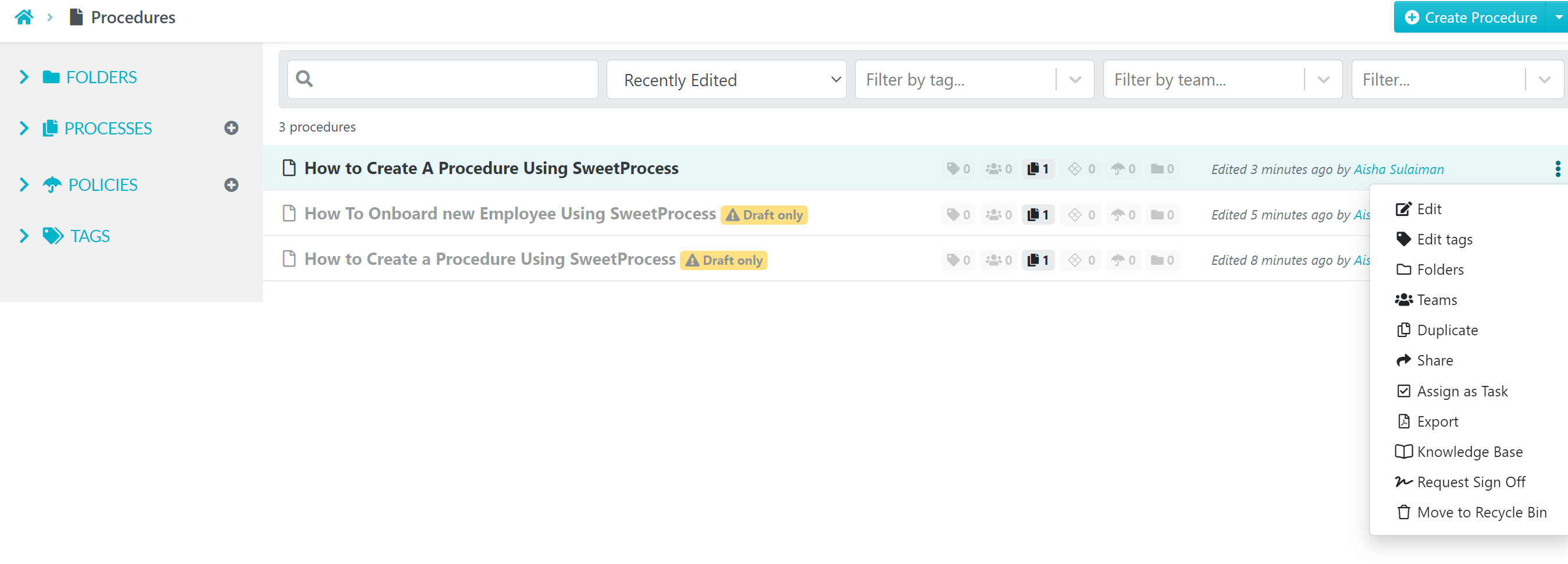
You can also use the search feature on your dashboard to find specific processes using related keywords. Simply enter the keyword in the search bar at the top of the page and click “Enter” to display the result.
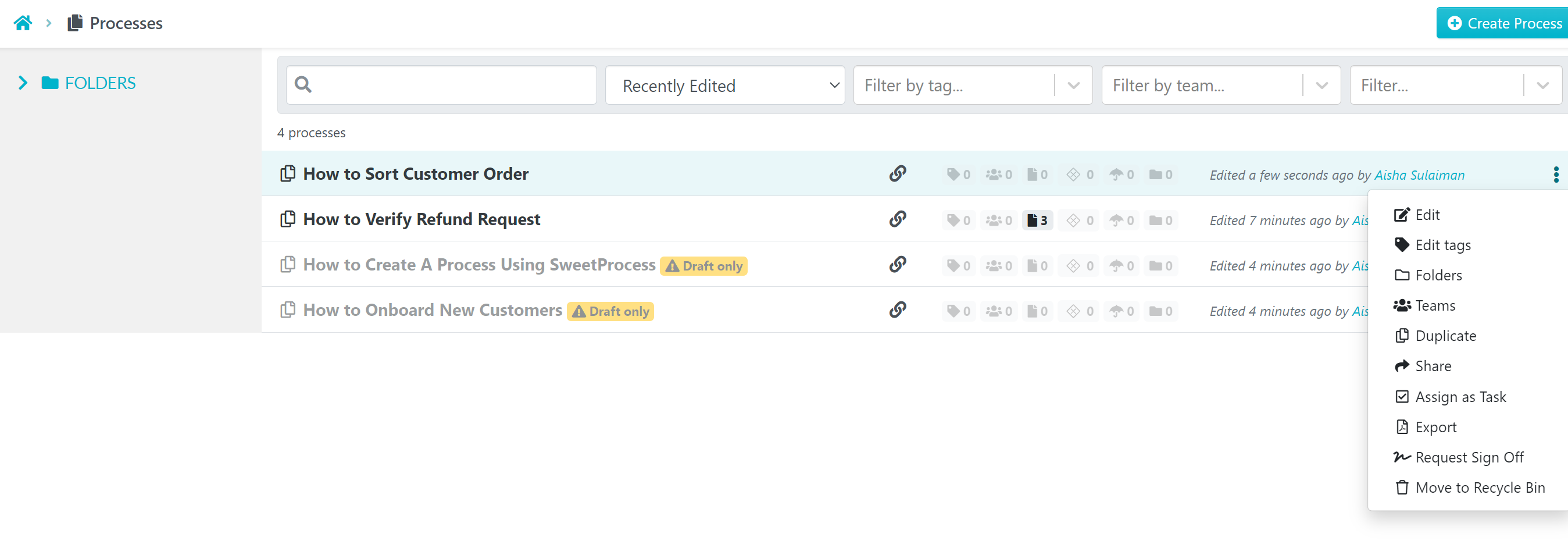
5. Assign Roles and Responsibilities
Ensure accountability by assigning specific roles to each procedure step. Tag the relevant team members, clarifying who is responsible for what. This helps track progress and ensure tasks are completed on time.
How to Create a Team and Collaborate With Them in Real Time
SweetProcess is an excellent platform for collaborating with your team. With your processes and procedures documented, you can use the following features to stay on track:
- The Filter: This allows you to sort processes that need your attention—for example, if a team member has requested approval to add a new process or requires you to sign. You can easily keep track and get it done.
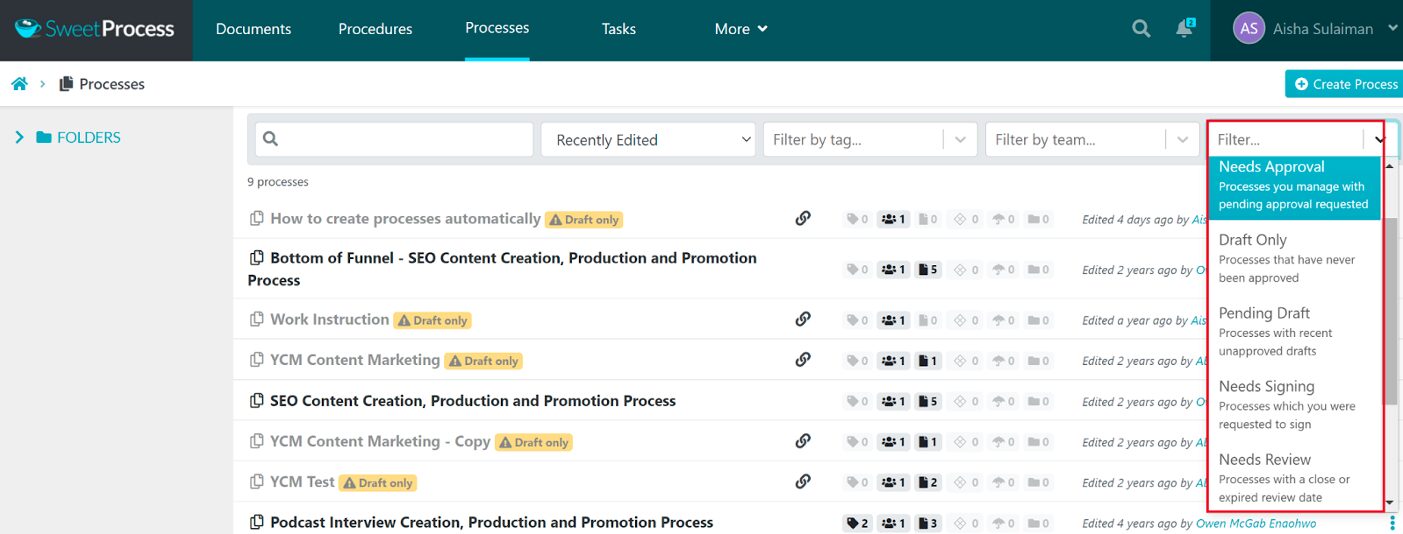
- The Comments: You can see comments left by team members for specific procedures when you open it. This displays in real-time, and replies can be sent easily.

- Teams: The teams associated with a particular process can be reviewed. You can add or remove accordingly based on your needs.
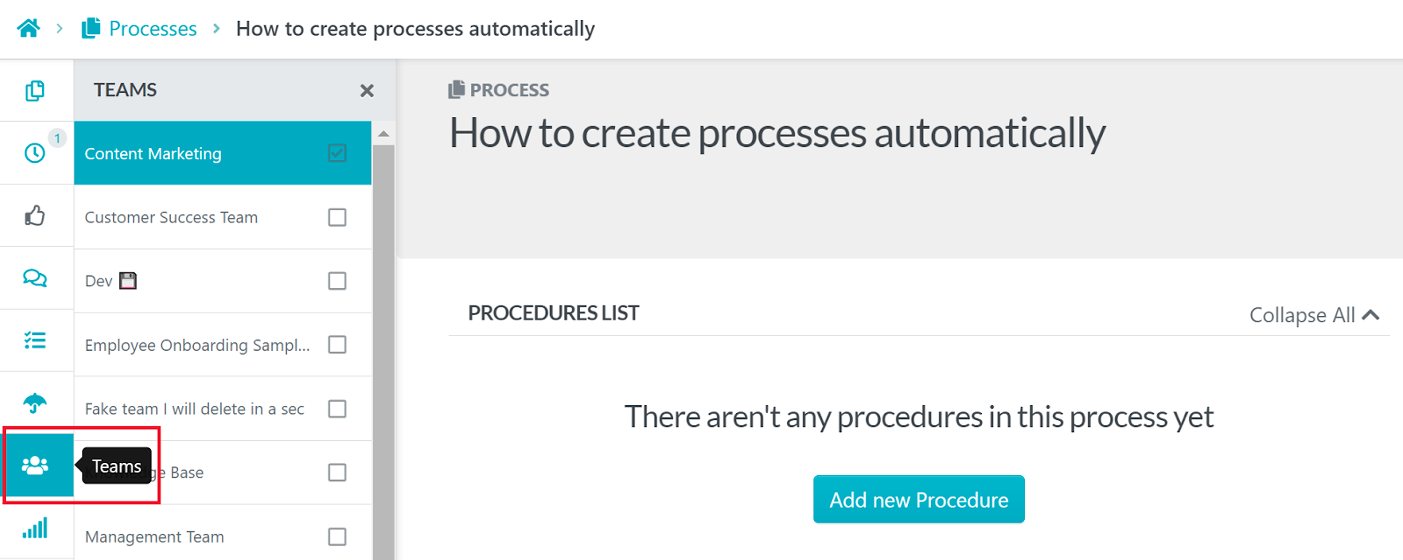
- Process Activity: This feature helps you keep track of team members using the process in question. It identifies the team members and indicates the time they viewed the process.
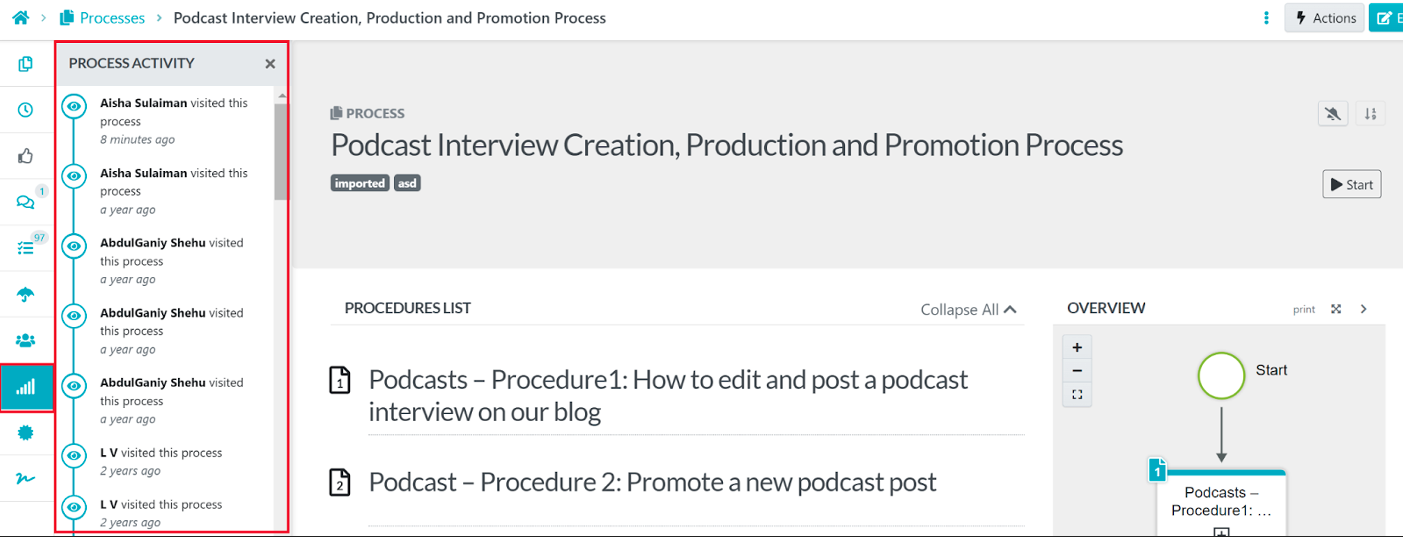
Overall, as a team manager, you have a great tool in your hands to help you stay organized and productive.
How to Turn Processes and Procedures Into Actionable Tasks
Another great feature of SweetProcess is that it allows you to convert documented processes and procedures into actionable tasks.
Use the task assignment feature to allocate specific steps to team members within a process or procedure. Set deadlines and add notes to guide task completion. This functionality ensures that documented processes lead to concrete actions and improved employee productivity.
To assign a process as a task, open the list of processes and click the three dots to the right of the process to be assigned.

Head over to the documented procedure list to assign a procedure as a task.

Click the three dots to the right of the procedure to be assigned.

Next, click “Assign,” then select the team member needed for the task for either the process or procedure. Add the due date and reminder, and then complete the process.
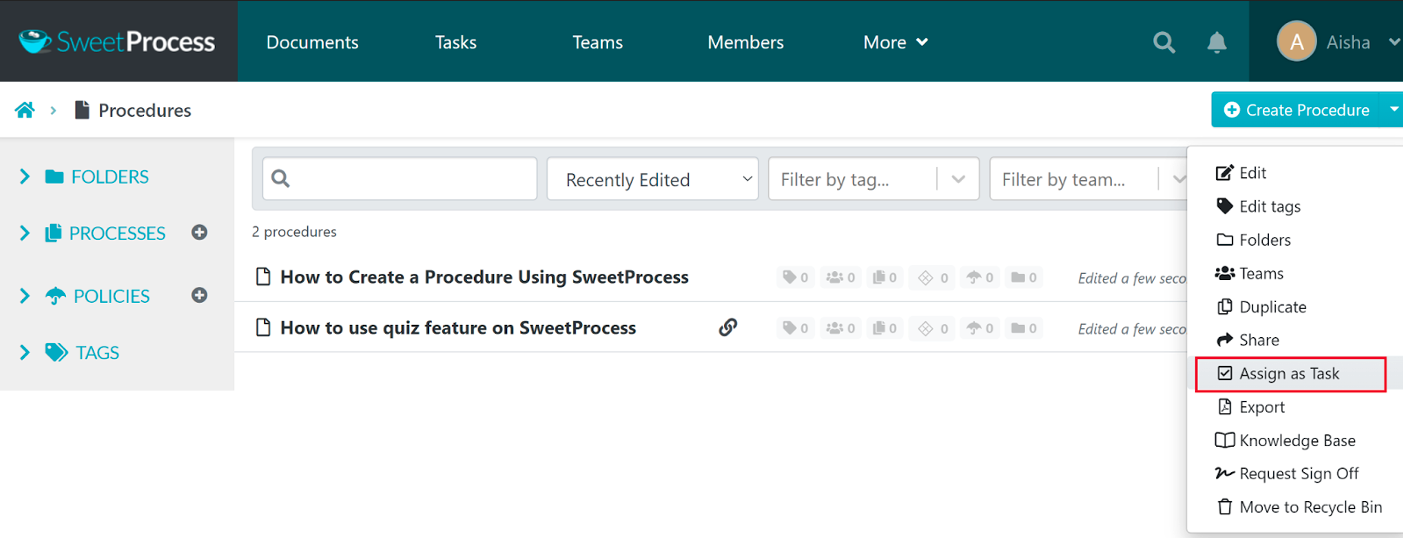
Tasks can also be assigned directly from the procedure while it is open from the “Actions” menu on the top right of the screen:
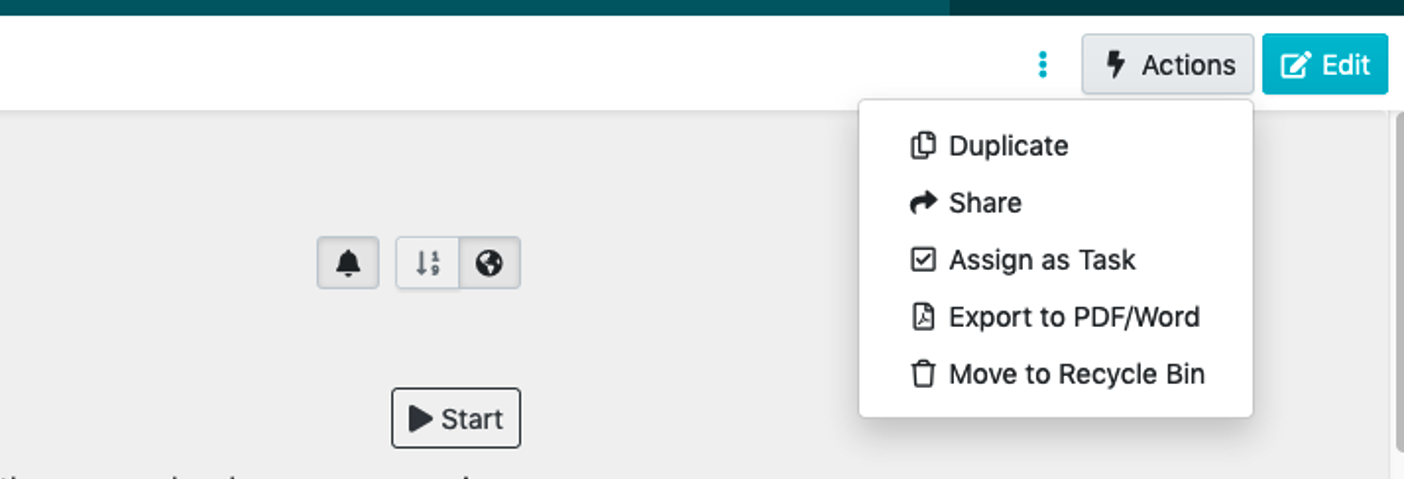
Tasks can be assigned to a single team member or an entire team, and once assigned, a notification is sent out immediately.
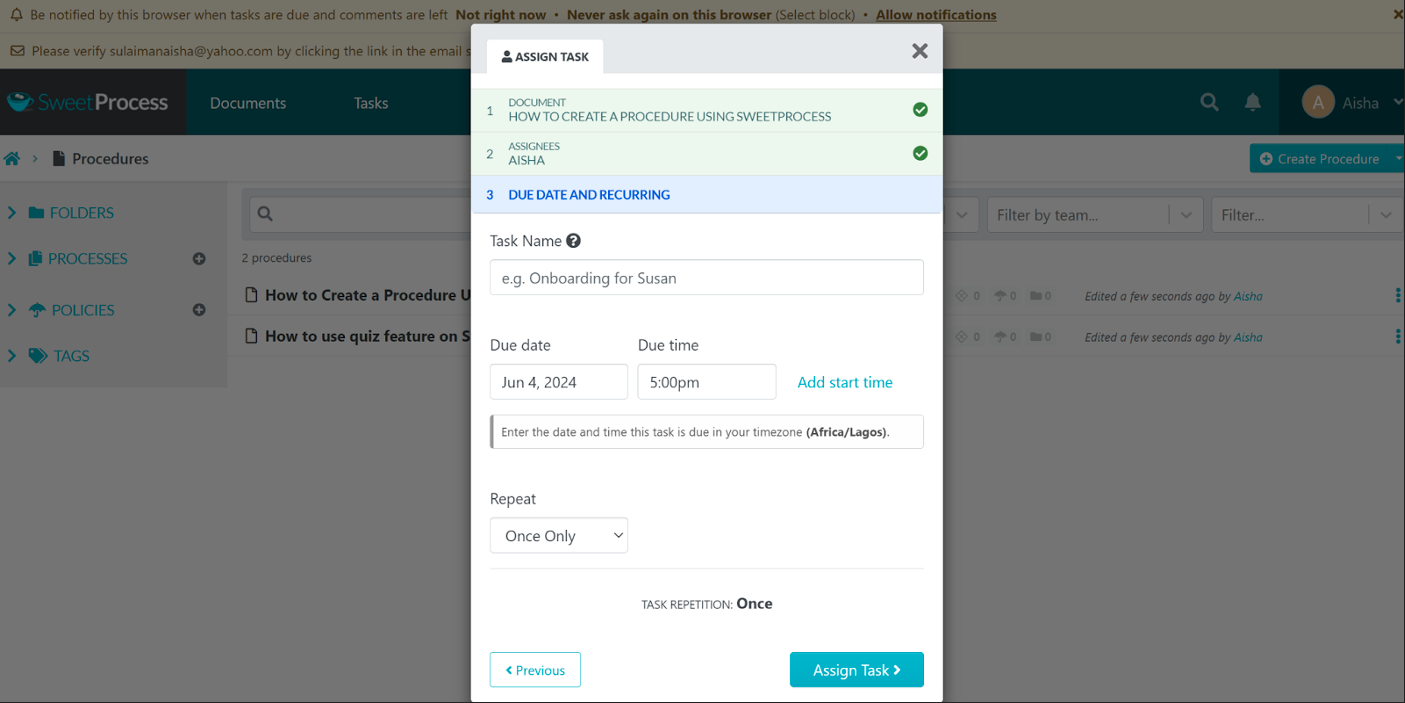
Tasks assigned properly help everyone follow the correct steps, reducing errors and improving efficiency.
SweetProcess is indeed a powerful tool that can help you turn chaos into order. Many businesses have embraced the platform, and you should too.
Thimbleberry Financial improved its employee onboarding and documentation processes with SweetProcess. The tool helped them create comprehensive and easily accessible training materials, which streamlined onboarding and allowed employees to perform tasks independently. This significantly reduced the time spent on training and increased overall productivity.
Belvidere Community School District also streamlined its operations using SweetProcess. They centralized their knowledge base, making information readily accessible to all stakeholders, which improved communication and efficiency. They also enhanced employee onboarding, ensuring new hires could quickly get up to speed without relying on outdated manuals.
Want to begin your transformation with a well-organized and highly productive team? Sign up for the 14-day free trial of SweetProcess today and experience how easy it is to create, manage, and optimize your processes and procedures.
7 Tools for Streamlining Your Business Processes

Nothing beats the satisfaction of a manager walking into the office and finding everyone effortlessly collaborating, seamlessly managing tasks, and customer interactions running smoothly. With the right tool, this can be achieved. Here are seven essential tools that can transform your business operations.
Business Process Management (BPM) Software
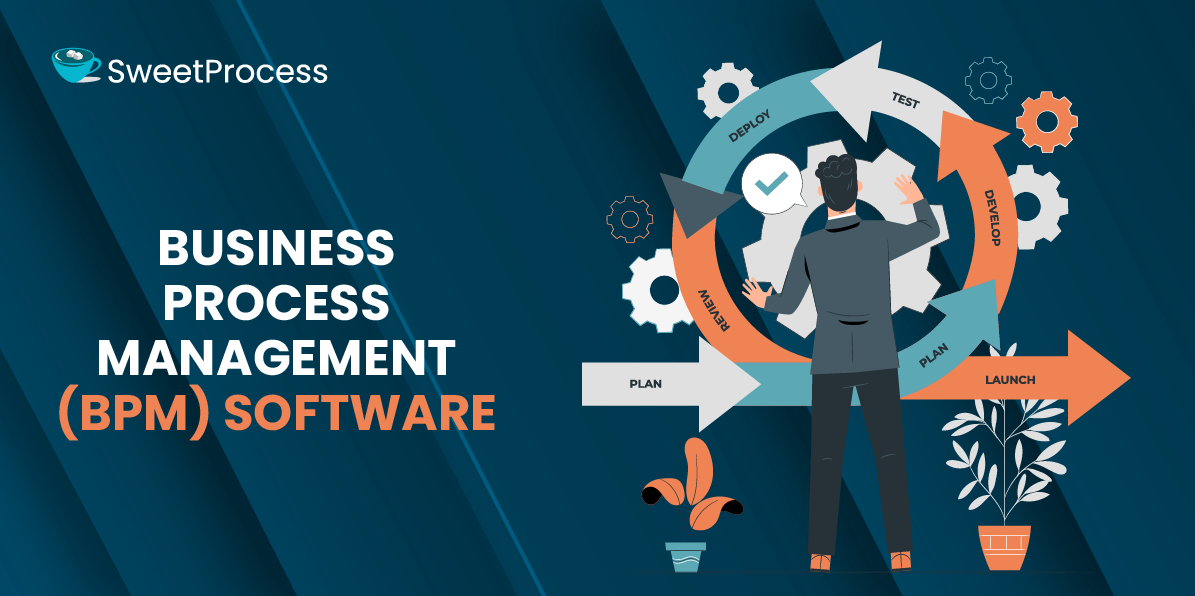
Business process management (BPM) involves systematically enhancing an organization’s operations’ efficiency and effectiveness. BPM software facilitates the design, modeling, execution, monitoring, and optimization of these processes. By automating routine tasks and providing a clear overview of workflows, BPM software ensures that business operations are efficient and consistent. It often includes tools for business process mapping, workflow automation, and performance monitoring.
Customer Relationship Management (CRM) Software
CRM software handles your company’s interactions with current and potential customers. It centralizes customer data, tracks interactions, and automates sales and support tasks. This boosts customer service, drives sales, and helps retain customers.
Project Management Software
Managing projects becomes easier with dedicated software that supports planning, execution, and tracking. These tools provide essential functions like task scheduling, resource management, and team collaboration. By centralizing all project information with Standard Operating Procedures, project management software helps teams stay on track and meet their deadlines efficiently.
Product Management and Development Software
This software supports the entire product development process from the initial concept through to the launch phase. It provides tools for managing tasks, prioritizing customer input, and tracking development milestones. This approach ensures that products meet market requirements and are delivered on schedule.
Legal, Accounting, and Finance Software

These tools are designed to streamline legal, accounting, and financial operations with distinct features. Legal software helps with contracts and compliance, accounting software handles bookkeeping and financial reporting, and finance software aids in budgeting and financial planning.
Human Resources and Marketing Software
HR and marketing efficiency gets a major upgrade with these tools. HR software streamlines tasks like payroll processing, benefits administration, and talent management, whereas marketing software takes care of campaign execution, social media interactions, and analytics. This synergy guarantees seamless HR workflows and impactful marketing efforts.
Personal Productivity Tools and Apps
Using these tools, you can manage your time and tasks more effectively. Personal productivity tools such as task managers, note-taking apps, and calendar programs help users remain organized, set task priorities, and enhance productivity.
The right software can make all the difference in your business, and you need to embrace technology to support its growth.
How to Choose the Business Processes to Streamline

You know the drill. You’re about to wrap up for the day when you realize you’ve spent hours shuffling papers or clicking through endless screens. Just when you think you’ve got everything under control, another tedious process trips you up.
So how do you identify the processes in your business that need to be streamlined to eliminate inefficiencies?
Things to consider:
- Time: Are you spending hours on repetitive tasks? If a task feels like a treadmill, constantly moving but getting nowhere, it’s time for a change. Look for bottlenecks in your processes. If something’s slowing you down, it’s worth investigating.
- Redundant Steps: Ask yourself: Are there steps that seem redundant? Are you filing the same information in three different places? Streamlining process here will save you precious time and resources.
- Errors: High error rates are red flags. If mistakes become frequent, the process might be too complicated or poorly designed. Evaluate the critical errors and start with those to make the job easier.
- Frequent Questions: If team members frequently ask for clarifications, it’s a sign the process might be too convoluted.
Smooth processes can still have hidden inefficiencies, so don’t overlook them. Streamlining means ensuring that every step in your process is valuable, not just reducing the number of steps. Scrutinize your workflows, and don’t hesitate to make changes.
9 Benefits of Streamlining Business Processes
Streamlining business processes has numerous benefits, improving overall organizational efficiency and effectiveness. Here are nine main benefits.
Improved Productivity
Streamlined business processes eliminate unnecessary tasks, allowing employees to concentrate on their main responsibilities. This leads to quicker project completion and better use of resources, significantly enhancing productivity.
Better Time Management

With streamlined processes, tasks are organized more efficiently, reducing time wasted on unproductive activities. This helps employees manage their time better, ensuring they effectively meet deadlines and handle priorities.
Improved Communication
Clear communication channels and protocols are established through a streamlined process. This ensures smooth information flow between departments, reducing misunderstandings and improving team collaboration.
Increased Cost Efficiency
Identifying and eliminating inefficiencies reduces operational costs. Streamlined processes minimize waste and optimize resource use, and they often need fewer workers, leading to significant cost savings.
Simplified Employee Training
Standardized processes make training new employees easier. Clear and consistent procedures help new hires quickly understand their roles, reducing the learning curve and enhancing workforce competence.
Minimum Risk Exposure
Efficient processes help identify and address risks early. Transparent workflows allow for better controls and safeguards, reducing the chance of errors and enhancing risk management.
Improved Accountability
Defined roles and processes improve accountability within the organization. Employees know their responsibilities and performance standards, making tracking and addressing issues easier.
Improved Customer Satisfaction
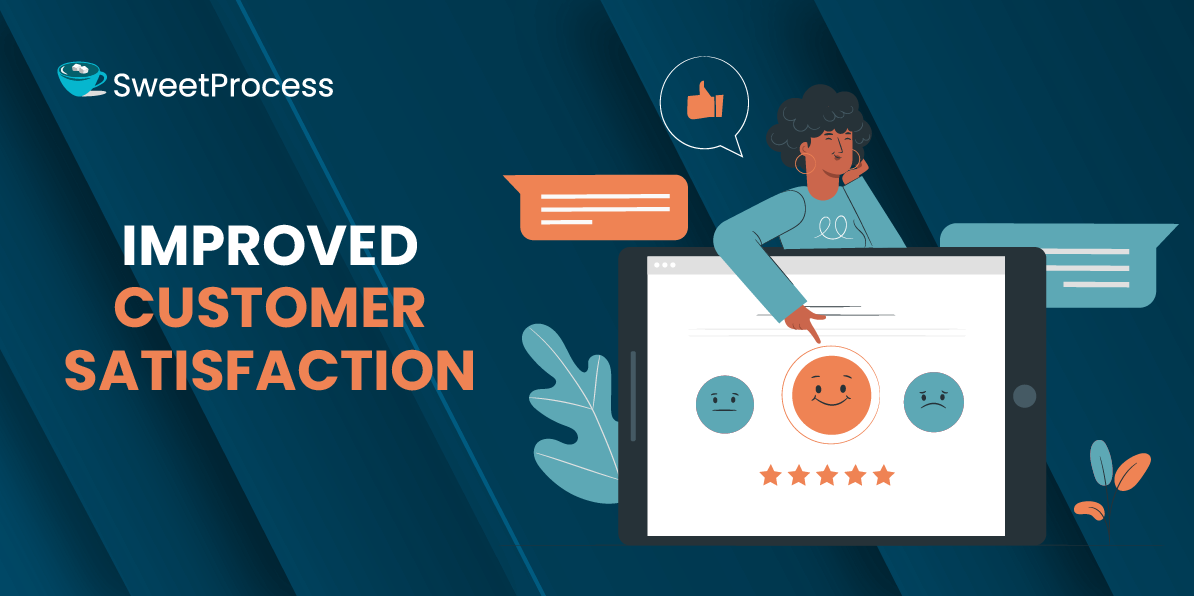
Streamlined operations lead to quicker service and higher-quality products. Smooth business processes result in fewer customer delays and issues, increasing satisfaction and loyalty.
Improved Compliance With Industry Standards
Streamlining ensures that operations align with industry regulations. Compliance helps avoid legal issues, enhance reputation, and build trust with clients and stakeholders.
These benefits collectively contribute to a more streamlined, cost-effective, and competitive business operation, enabling your business to thrive.
The journey to streamlining your processes is a long and continuous one. SweetProcess is a great place to start, and you can take advantage of the 14-day free trial to get the ball rolling.
7 Methodologies for Streamlining Business Processes
Many companies face inefficiencies as a result of redundant tasks and unclear workflows. Streamlining business processes provides the solution by converting chaos into order and enhancing productivity. To achieve this transformation, consider using the following effective methodologies.
Lean Management
Lean management aims to increase customer value while minimizing resources. It focuses on eliminating waste, whether time, materials, or effort. By honing in on what truly adds value, your business can streamline its processes and operate more efficiently. Think of it as decluttering your workspace—everything flows better when there’s less in the way.
Six Sigma
Six Sigma aims to achieve near perfection by reducing process defects and variability. It’s a data-driven approach that uses statistical tools to identify and eliminate causes of errors. It’s like having a well-tuned engine when processes are consistent and reliable. The smoother it runs, the further your business can go.
Business Process Reengineering (BPR)
BPR involves radically redesigning your core business processes to dramatically improve productivity, cycle times, and quality. By rethinking your work process, businesses can break free from outdated practices and create more efficient and effective processes.
Total Quality Management (TQM)
TQM is a comprehensive approach that seeks continuous improvement in all aspects of a business. It emphasizes quality in every process, from product design to customer service. When quality becomes a part of the organizational culture, everything improves.
Kaizen
Kaizen, a Japanese term meaning “continuous improvement,” involves regularly making small, incremental changes. This is not an overnight transformation but steady progress. Like a gardener tending to their plants, consistent attention and care lead to a thriving, productive environment.
Agile Methodology
Initially developed for software development, agile methodology promotes flexible, iterative progress. Emphasizing cooperative efforts, it integrates regular customer feedback and aims for swift, small-scale releases. Agile allows businesses to adapt quickly to changes and continuously improve their processes.
Business Process Management (BPM)
BPM involves modeling, analyzing, and optimizing business processes. It provides a structured approach to improving workflows and ensuring they align with business goals. With clear plans and procedures, your business will operate more efficiently and effectively.
Each of these methodologies offers unique advantages and can be tailored to your business needs. Integrating these approaches allows you to create a streamlined, agile, responsive organization ready to tackle any challenge.
The journey to efficiency might be complex, but with the right tools and mindset, the destination is well worth it.
Streamline Your Company’s Processes Effectively Using SweetProcess
We’ve discussed how streamlining your company’s processes can change workflow process dynamics.
Imagine a future where tasks are executed seamlessly, approvals are quick, and every team member knows what to do. Hours wasted on manual data entry, endless email chains, and constant follow-ups will become a thing of the past.
When complex processes are streamlined, repetitive tasks are reduced, and bottlenecks are eliminated, valuable time can be freed up to focus on innovation, growth, and better service delivery.
Wealth management firms, financial advisors, and many other business owners across several sectors have been transforming their operations with SweetProcess. They’ve centralized knowledge, improved communication, and enhanced employee onboarding, among others, and you can achieve the same too.
Experience how easy it is to create, manage, and optimize your processes and procedures. Sign up today for the 14-day free trial of SweetProcess to start on your journey to efficiency and productivity.

